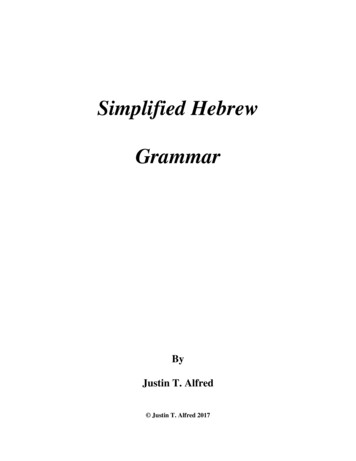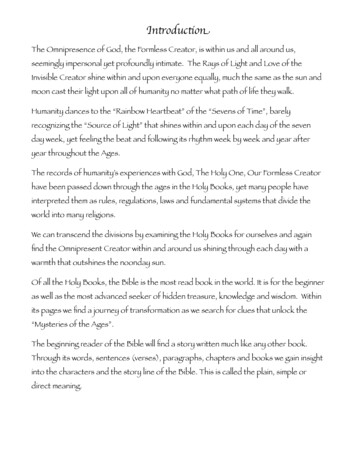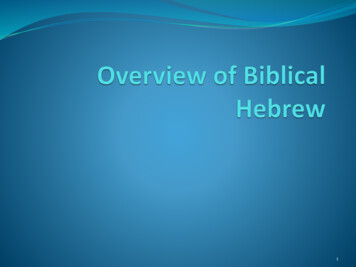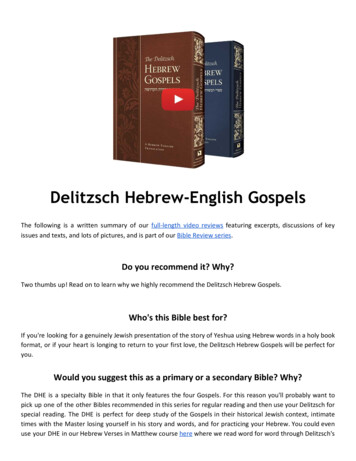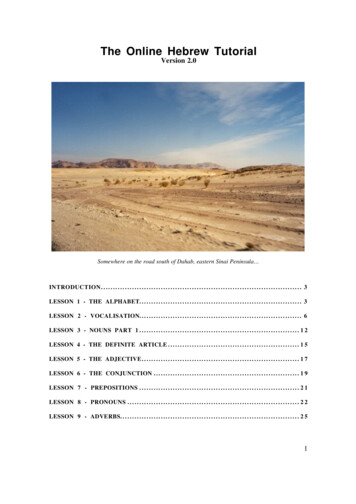
Transcription
The Online Hebrew TutorialVersion 2.0Somewhere on the road south of Dahab, eastern Sinai Peninsula INTRODUCTION. . . . . . . . . . . . . . . . . . . . . . . . . . . . . . . . . . . . . . . . . . . . . . . . . . . . . . . . . . . . . . . . . . . . . . . . . . . . . . . . . . . . 3LESSON 1 - THE ALPHABET. . . . . . . . . . . . . . . . . . . . . . . . . . . . . . . . . . . . . . . . . . . . . . . . . . . . . . . . . . . . . . . . . . . . 3LESSON 2 - VOCALISATION. . . . . . . . . . . . . . . . . . . . . . . . . . . . . . . . . . . . . . . . . . . . . . . . . . . . . . . . . . . . . . . . . . . . 6LESSON 3 - NOUNS PART 1 . . . . . . . . . . . . . . . . . . . . . . . . . . . . . . . . . . . . . . . . . . . . . . . . . . . . . . . . . . . . . . . . . . . 1 2LESSON 4 - THE DEFINITE ARTICLE . . . . . . . . . . . . . . . . . . . . . . . . . . . . . . . . . . . . . . . . . . . . . . . . . . . . . . . 1 5LESSON 5 - THE ADJECTIVE. . . . . . . . . . . . . . . . . . . . . . . . . . . . . . . . . . . . . . . . . . . . . . . . . . . . . . . . . . . . . . . . . . 1 7LESSON 6 - THE CONJUNCTION . . . . . . . . . . . . . . . . . . . . . . . . . . . . . . . . . . . . . . . . . . . . . . . . . . . . . . . . . . . . . 1 9LESSON 7 - PREPOSITIONS . . . . . . . . . . . . . . . . . . . . . . . . . . . . . . . . . . . . . . . . . . . . . . . . . . . . . . . . . . . . . . . . . . . 2 1LESSON 8 - PRONOUNS . . . . . . . . . . . . . . . . . . . . . . . . . . . . . . . . . . . . . . . . . . . . . . . . . . . . . . . . . . . . . . . . . . . . . . . . 2 2LESSON 9 - ADVERBS. . . . . . . . . . . . . . . . . . . . . . . . . . . . . . . . . . . . . . . . . . . . . . . . . . . . . . . . . . . . . . . . . . . . . . . . . . . 2 51
LESSON 10 - VERBS PART 1 . . . . . . . . . . . . . . . . . . . . . . . . . . . . . . . . . . . . . . . . . . . . . . . . . . . . . . . . . . . . . . . . . . 2 6LESSON 11 - VERBS PART 2 . . . . . . . . . . . . . . . . . . . . . . . . . . . . . . . . . . . . . . . . . . . . . . . . . . . . . . . . . . . . . . . . . . 2 9LESSON 12 - VERBS PART 3 . . . . . . . . . . . . . . . . . . . . . . . . . . . . . . . . . . . . . . . . . . . . . . . . . . . . . . . . . . . . . . . . . . 3 6LESSON 13 - NUMBERS. . . . . . . . . . . . . . . . . . . . . . . . . . . . . . . . . . . . . . . . . . . . . . . . . . . . . . . . . . . . . . . . . . . . . . . . . 3 9LESSON 14 - NOUNS PART 2. . . . . . . . . . . . . . . . . . . . . . . . . . . . . . . . . . . . . . . . . . . . . . . . . . . . . . . . . . . . . . . . . . 4 3LESSON 15 - DIFFERENCES BETWEEN MODERN AND BIBLICAL HEBREW. . . . . . 4 7LESSON 16 - WEAK VERBS. . . . . . . . . . . . . . . . . . . . . . . . . . . . . . . . . . . . . . . . . . . . . . . . . . . . . . . . . . . . . . . . . . . . 4 9LESSON 17 – VERBS PART 4. . . . . . . . . . . . . . . . . . . . . . . . . . . . . . . . . . . . . . . . . . . . . . . . . . . . . . . . . . . . . . . . . . 5 2RECOMMENDATIONS FOR FURTHER STUDY. . . . . . . . . . . . . . . . . . . . . . . . . . . . . . . . . . . . . . . . . . . . 5 8USEFUL RESOURCES . . . . . . . . . . . . . . . . . . . . . . . . . . . . . . . . . . . . . . . . . . . . . . . . . . . . . . . . . . . . . . . . . . . . . . . . . . . 5 9ONLINE RESOURCES. . . . . . . . . . . . . . . . . . . . . . . . . . . . . . . . . . . . . . . . . . . . . . . . . . . . . . . . . . . . . . . . . . . . . . . . . . . . 6 0APPENDIX A – ORIGIN OF THE ALPHABET. . . . . . . . . . . . . . . . . . . . . . . . . . . . . . . . . . . . . . . . . . . . . . . 6 0APPENDIX B – THE CURSIVE ALPHABET . . . . . . . . . . . . . . . . . . . . . . . . . . . . . . . . . . . . . . . . . . . . . . . . . 6 3APPENDIX C – THE TETRAGRAMMATON . . . . . . . . . . . . . . . . . . . . . . . . . . . . . . . . . . . . . . . . . . . . . . . . . 6 5ERRATA. . . . . . . . . . . . . . . . . . . . . . . . . . . . . . . . . . . . . . . . . . . . . . . . . . . . . . . . . . . . . . . . . . . . . . . . . . . . . . . . . . . . . . . . . . . . . 6 7FEEDBACK . . . . . . . . . . . . . . . . . . . . . . . . . . . . . . . . . . . . . . . . . . . . . . . . . . . . . . . . . . . . . . . . . . . . . . . . . . . . . . . . . . . . . . . . . 6 7ANSWERS TO EXERCISES . . . . . . . . . . . . . . . . . . . . . . . . . . . . . . . . . . . . . . . . . . . . . . . . . . . . . . . . . . . . . . . . . . . . . 6 7LESSON 2 – VOCALISATION .67LESSON 3 – NOUNS PART 1 .68LESSON 4 – THE DEFINITE ARTICLE.68LESSON 5 - THE ADJECTIVE .69LESSON 6 - THE CONJUNCTION.69LESSON 7 - PREPOSITIONS.70LESSON 9 - ADVERBS .70LESSON 13 - NUMBERS .70PICTURE CREDITS. . . . . . . . . . . . . . . . . . . . . . . . . . . . . . . . . . . . . . . . . . . . . . . . . . . . . . . . . . . . . . . . . . . . . . . . . . . . . . . 7 1BIBLIOGRAPHY . . . . . . . . . . . . . . . . . . . . . . . . . . . . . . . . . . . . . . . . . . . . . . . . . . . . . . . . . . . . . . . . . . . . . . . . . . . . . . . . . . . 7 1Copyright 1998-2000 by Ben Stitz. Free, however all rights reserved.Redistribution is permitted provided that (a) this copyright notice is duplicated in all such forms and that anydocumentation, advertising materials and other materials related tosuch distribution and use acknowledge that the material was developed byBen Stitz and(b) that the material is distributed in its original unmodified form,2
with the accompanying Java application.(c) unlimited hard or soft copies are permitted for student or teacher use.(d) may be included on CD software collections.THIS MATERIAL IS PROVIDED "AS IS" AND WITHOUT ANY EXPRESS OR IMPLIEDWARRANTIES, INCLUDING, WITHOUT LIMITATION, THE IMPLIED WARRANTIES OFMERCHANTABILITY AND FITNESS FOR A PARTICULAR PURPOSE.IntroductionThis tutorial teaches both Biblical and Modern Hebrew, with an emphasis on ModernHebrew as spoken in the State of Israel today. This is because with Hebrew, the past cannotbe meaningfully separated from the present.The latest version of this document is available at http://foundationstone.com.au/ – if youhave not already done so, put yourself on the mailing list for updates by following theinstructions on that page.A file "OnlineHebrewTutorial.pdf" is available in the distribution. If you have the AdobeAcrobat viewer (available free of charge at http://www.adobe.com/) a high quality papercopy can be made. For those who need a larger print version, one is available for downloadat The tutorial is a complete course. However, it is also designed for use with whatever otherlearning materials you find useful, interesting or beneficial. Master the lessons in the orderindicated, and do all the exercises for full results.Due to the goal of advancing the student as rapidly as possible, the course is heavy going inparts, and may not be a favourite to those who prefer a gentler pace. There is extensive, buthopefully not unnecessary, grammar. It is what I would have liked people to have told mewhen I was learning, and fills a gap that I feel exists in the courses I have seen.Like all skills Hebrew requires considerable effort to learn - it takes some time before it allstarts to make sense. I hope you persevere until you reach that point.Lesson 1 - The AlphabetA good place to start is at the beginning, and Hebrew begins with an alphabet (infact thealphabet). Don’t be too concerned that the following table looks very unfamiliar at firstglance.Here is the Hebrew Alphabet –PrintedNameCursiveTransliterationValue1’3
v; b2gh; g3dh; d4h5v6z7ch8t9y10kh; k20l30m40n50s60 70ph, p80tz904
q100r200s; sh300t400There is also an alphabet used prior to the Babylonian exile, which appears onarchaeological relics. Interested readers are referred to “Appendix A – Origin of theAlphabet”.Basic Principles:Hebrew uses an alphabet of 22 consonants. It is written from right to left, top to bottom.Notice that the consonants “ ”, “ ”, “ ”, “ ” and “ ” when appearing at the end of aword take what is called the final forms “ ”, “ ”, “ ”, “ ” and “ ” respectively.Thus “” not “”.The symbols written above and below the consonants are the vowels – these will be coverednext lesson, so ignore them for now.Note that the pronunciations given in the table are Sephardi (originating from Spain andNorth Africa), and is the pronunciation used in the State of Israel. Many communities usethe Ashkenazi (German) pronunciation – the most obvious difference is that “ ” ispronounced “s” as in “Shabbas”, rather than “Shabbat” for, the day of rest.Difficult Letters:People who speak European languages often have problems pronouncing “ ”, “ ” and“ ”; “ ” and “ ” .“ ” has a peculiar throaty sound, whereas “ ” and “ ” are indistinguishable.“ ” is simply a pause, like in the word “o’clock”.“ ” is the hardest to describe – it is like clearing your throat.Shortly, we will be using a video to learn them.Exercise 1a:5
Referring to the table above, learn the printed alphabet and try to and become familiar withthe cursive (modern handwritten) letters along the way. Learn to recognise the letters andtheir transliterations (you will be unable to read their names until the next exercise).Practice reading and writing them in alphabetical order. The Hebrew numerical values arerarely used in Modern Hebrew (a modern text contains the familiar Arabic numerals 1-10,so you can ignore them for now).Exercise 1b:Browse the link: foundationstone.com.au/ListeningSkills.html and follow the instructions toinstall the QuickTime media layer (if necessary). Quicktime enables your computer to playthe various multimedia files used in this tutorial. Download and play the “Alphabet.mov”video. The speaker will read from the above table, follow along and practice producing thecorrect sounds and saying the names of the letters. In particular pay close attention to “ ” ,“ ” and “ ”; “ ” and “ ” .Exercise 1c:When you think you know the table, go into FoundationStone and learn the letterpronunciations, without listening to “Alphabet.mov”. Select the “Alphabet” word typefilter, and practice.Optional Exercise 2a:Redo exercise 1a, but with the emphasis on learning the cursive (handwritten) script. Youwill need to consult “Appendix B – The Cursive Alphabet” before proceeding.Optional Exercise 2b:When you think you know the table, go into FoundationStone and select the “Alphabet”word types from the filter menu. In the Edit menu, select “General Preferences.”. Clickon the “Handwritten Hebrew” button, then the “Apply” button to change the font. Practicerecognising the cursive letters. When you are finished return to the printed Hebrew font.Optional Exercise 2c:Return to the printed font, and redo exercise 1c, this time learning the numerical values ofthe letters. This is chiefly for Biblical Hebrew students who are interested in the topic ofGematria (where words are given numerical values equal to the sum of the consonants thatcompose them).Lesson 2 - Vocalisation6
To pronounce consonants together in a word, we need to have some vowels between them,and some rules for how to do it.Here are the Hebrew vowels –SymbolNameVocalisationvowel short "a" like a in fathervowel short "e" like e in getvowel short "i" like i in lidvowel short "o" like o in topvowel short "u" like u in butvowel long "a" like a in barvowel long "ae" like e in hey (or a in may)vowel long "ae" like e in hey (or a in may)vowel long "i" like the final i in Israelivowel long "o" like o in overvowel long "o" like o in overvowel long "u" like u in tubesilent OR vowel "very short e" like first a in bananavowel "very short a" like a in lathervowel "very short e" like e in elf7
vowel "very short o" like o in colicBasic Principles:Hebrew is a phonetic language – it is spoken how it is written. Therefore at the end of thislesson you will be able to correctly pronounce or follow a reading of any written text that ispointed, or has niqudot.are the signs appearing above and below the line of thetext. In a modern Israeli newspaper or book, the vowels are dropped (reappearingoccasionally if the pronunciation of a word is unusual). After some familiarity with thelanguage, you will be able to anticipate these vowels from their context and supply themmentally.Essentially, Hebrew is a language of consonants, with vowels placed between them to aidpronunciation. Therefore, it is unnatural to say two consonants one after the other. Whenthis is necessary, a device called the Seva (see below) is used.thThe vowel symbols above were invented around the 8 Century CE by a group called theMassoretes, as an aid to correct pronunciation. They devised a scheme having vowel signs(previously supplied by a reader intimately familiar with the texts) explicitly written aboveand below the sacred (and therefore inalterable) text of consonants. Today, a Torah scroll (ieGenesis through Deuteronomy) is still written withoutand must be read aloud byan expert (or thoroughly rehearsed) reader. Note that Hebrew was successfully writtendown for at least 2000 years without recording the vowels. This was possible becausesome consonants, specifically “ ”, “ ” and “ ” can also be used as vowels: (eg“ ” is associated with “ ”; “ ” is used in vowels “ ” and “ ”; and “ ” is used invowels “ ” and “ ”). This conce
on the “Handwritten Hebrew” button, then the “Apply” button to change the font. Practice recognising the cursive letters. When you are finished return to the printed Hebrew font. Optional Exercise 2c: Return to the printed font, and redo exercise 1c, this time learning the numerical values of the letters. This is chiefly for Biblical .File Size: 670KBPage Count: 72Explore furtherThe Cambridge Introduction to Biblical Hebrewassets.cambridge.orgBIG Collection of Learn Hebrew PDF Lessons - FREE.www.linguajunkie.comRead the Bible in Hebrewwww.torahinmyheart.comModern Hebrew: An Essential Grammar - Alex Alejandrealexalejandre.comRecommended to you based on what's popular Feedback


